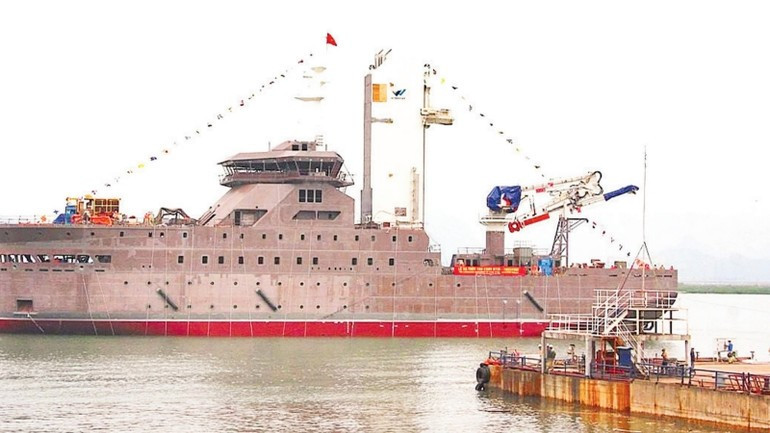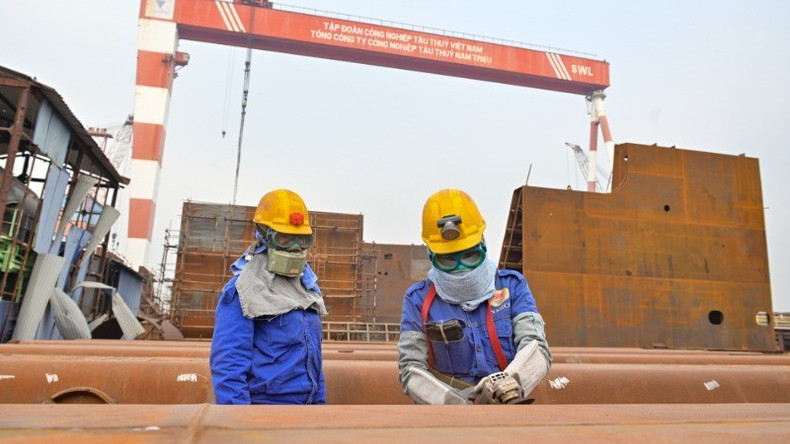Viet Nam’s shipbuilding industry embraces green energy transition
Amidst escalating climate challenges and a global push for sustainability, Viet Nam’s shipbuilding industry is accelerating its shift toward a green transition. This evolution is not only an inevitable trend but also a strategic opportunity to enhance capacity, meet environmental standards, and contribute to Viet Nam’s commitment to achieving net zero emissions by 2050.

A sector in transformation
The net zero pledge has profoundly impacted all socio-economic sectors, including shipbuilding. Additionally, the International Maritime Organisation (IMO) has tightened regulations on greenhouse gas emissions, mandating the reduction of sulphur and other pollutants in marine fuels. The adoption of new energy sources — such as liquefied natural gas (LNG), methanol, and hydrogen — has become essential, prompting fleets to overhaul their energy systems or replace older vessels.
Viet Nam’s shipbuilding industry stands at a pivotal moment. The global industry’s gradual shift from Europe to Asia presents a valuable opportunity for Vietnamese shipbuilders to innovate with green designs, integrating low-emission technologies for both domestic and export markets.
As of December 2024, Viet Nam has 1,490 registered seagoing vessels and watercraft, with expectations for this number to grow to 1,600–1,750 by 2030.
Pham Hoai Chung, Chairman of the Members’ Council of the Shipbuilding Industry Corporation (SBIC), reports that nearly 90 enterprises nationwide are engaged in seagoing shipbuilding, while more than 410 facilities focus on inland waterway vessels.
Viet Nam’s shipbuilding industry has produced a diverse range of high-quality vessels, including 70,000 DWT bulk carriers, 1,700 TEU container ships, and 10,000–20,000 DWT oil-chemical tankers, as well as specialised tugboats, patrol boats, and oil and gas service vessels. The country now ranks seventh globally in terms of shipbuilding capacity.
Strategic measures for a sustainable future

Recognising the urgent need for greener maritime activities, in 2022, the prime minister issued Decision No. 876/QD-TTg, approving an action programme on green energy transition and carbon and methane reduction in the transport sector. This roadmap sets clear targets for the shipbuilding industry, aligning it with international environmental standards.
From 2031 to 2050, domestic vessels must comply with Annex VI of the International Convention for the Prevention of Pollution from Ships (MARPOL Convention), adhering to air pollution prevention standards — including reduced emissions of nitrogen oxides (NOx) and sulphur oxides (SOx). By 2035, newly built, converted, or imported vessels will transition to electricity and green energy, with the ultimate goal of achieving 100% domestic fleet electrification by 2050.
The green transition will open opportunities to elevate Viet Nam’s shipbuilding industry, enabling it to build vessels that meet international standards for emissions, environmental safety, and operational efficiency.
Hoang Hong Giang, Deputy Director of the Viet Nam Maritime and Inland Waterways Administration, emphasises the importance of solutions related to infrastructure, investment incentives, human resources, and technology to successfully implement these changes.
To drive Viet Nam’s shipbuilding industry toward sustainability, experts recommend several key measures, including integrate green goals into shipbuilding development strategies, establishing financial incentives for low-emission shipbuilding projects, revising the Investment Law and Tax Law to provide better support for shipbuilding enterprises, and upgrading port infrastructure, particularly deep-water ports, to facilitate clean fuel supply for LNG, methanol, and electric vessels.
They suggested amending Decree No. 111/2015/ND-CP to include shipbuilding in Viet Nam’s list of supported industries; enabling preferential loans and investment incentives; and strengthening supply chain collaboration with metallurgy, precision mechanics, and electronics to ensure synchronised industry growth
It is also necessary to enhance human resource development through partnerships between universities, colleges, and enterprises, providing both theoretical and hands-on training
Shipbuilding units should invite foreign experts and collaborate with international shipyards to accelerate technological advancements.
The green transition presents Viet Nam’s shipbuilding industry with a unique chance to solidify its position in the global market, producing vessels that meet international standards for emissions, environmental safety, and operational efficiency.
With the right mechanisms, supportive policies, and determined enterprise engagement, Viet Nam’s shipbuilding sector is poised for a breakthrough, reinforcing its pivotal role in marine economic development while contributing meaningfully to the country’s Net Zero commitment.








